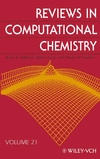Ab Initio Quantum Simulation in Solid State Chemistry
Book Series:Reviews in Computational ChemistrySummary
Chapter 1 provides a tutorial on calculating structures, properties and energies of solid state chemical systems using ab initio quantum methods. Concepts covering the direct lattice, reciprocal lattice, Bloch theorem and periodic boundaries are followed by the development of the one electron Hamiltonian in a lucid section on invariance properties in a crystal. A discussion of band structure follows with examples of one- two- and three-dimensional systems. Cohesive energy, polymorphism, magnetic phases and positional isomorphous phases are described. Modeling surfaces and interfaces is described next which is then followed by a tutorial on modeling of defects in solids. What a novice modeler is allowed to do and pitfalls for that person to avoid are given throughout the chapter. As crystal engineering and nanoscience continues to grow in importance, aspects of simulating solid state behavior will become more and more important and consequently the material described in this chapter will become more relevant to many bench chemists. The chapter consists of:
-
Introduction
-
Translation Invariance Properties in a Crystal
-
The Direct Lattice
-
The Reciprocal Lattice
-
Bloch Theorem and Periodic Boundary Conditions
-
One-electron Electrostatic Hamiltonian
-
-
Discussion of Band Structure Through a Few Simple Examples
-
A Monoatomic Linear Chain
-
A Two-dimensionally Periodic Example: Graphite
-
Three-dimensionally Periodic Examples
-
From the Band Structure to the Total Energy
-
Use of Symmetry in Reciprocal Space
-
-
Total Energy, Energy Differences and Derivatives
-
Cohesive Energy
-
Polymorphism
-
Magnetic Phases
-
Positional Isomorphous Phases
-
Energy Derivatives
-
-
Modeling Surfaces and Interfaces
-
The Slab Model
-
Specifying the Surface Plane-Miller Indices
-
Choosing the Surface Termination
-
Surface Formation Energy and Stability
-
Surface Relaxation and Reconstruction
-
Vicinal Surfaces-Modeling Steps and Kinks
-
Adsorption on Surfaces
-
Interfaces
-
-
Modeling Defective Systems
-
Defects in Solids
-
How to Model a Defect
-
The Supercell Approach
-
Defect Formation Energy
-
Examples
-
-
Conclusions
-
Appendix
-
References



